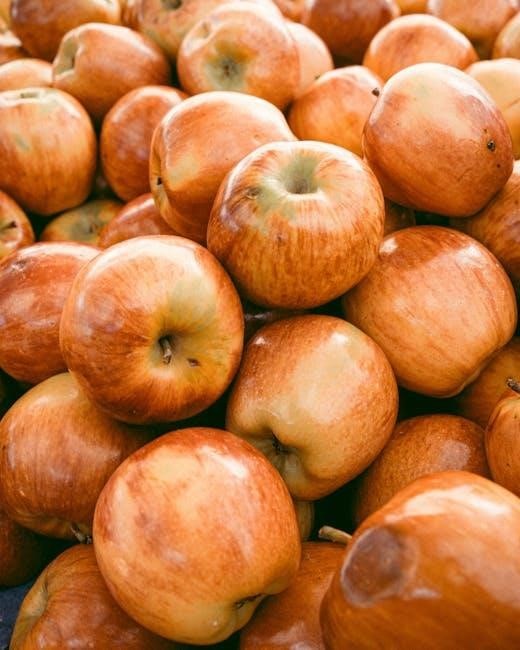SIBO Diet Food List PDF: A Comprehensive Guide
Navigating the SIBO diet can be complex‚ so a comprehensive guide in PDF format offers a convenient resource․ This PDF outlines foods that ease symptoms by minimizing bacterial fermentation․ It details what to eat and avoid‚ aiding in dietary management․
Understanding SIBO

Small Intestinal Bacterial Overgrowth‚ or SIBO‚ is a condition characterized by an excessive amount of bacteria in the small intestine․ Normally‚ the small intestine has a relatively low concentration of bacteria compared to the colon․ In SIBO‚ bacteria‚ often from the colon‚ migrate or proliferate abnormally in the small intestine․ This overgrowth can interfere with digestion and nutrient absorption‚ leading to a variety of symptoms․
Understanding SIBO is crucial for effectively managing it․ The bacteria present in the small intestine can ferment carbohydrates‚ producing gas and causing bloating‚ abdominal pain‚ and altered bowel habits․ Furthermore‚ these bacteria can damage the lining of the small intestine‚ leading to leaky gut and malabsorption of essential nutrients‚ including vitamins and minerals․
The root causes of SIBO are diverse and can include structural abnormalities in the small intestine‚ motility disorders that slow down the movement of food‚ immune system dysfunction‚ and certain medications․ Accurate diagnosis and identification of the underlying cause are essential for developing a targeted treatment plan․
What is SIBO (Small Intestinal Bacterial Overgrowth)?
SIBO‚ or Small Intestinal Bacterial Overgrowth‚ occurs when there’s an abnormal increase in the bacterial population in the small intestine․ Unlike the colon‚ the small intestine typically maintains a relatively low bacterial count․ SIBO disrupts this balance‚ leading to various digestive issues․
This overgrowth can result from several factors‚ including impaired gut motility‚ structural abnormalities in the small intestine‚ or deficiencies in digestive enzymes․ When bacteria proliferate excessively‚ they can interfere with the normal digestive process․ They ferment carbohydrates‚ producing gases like hydrogen and methane‚ which cause bloating‚ abdominal discomfort‚ and altered bowel habits․
Moreover‚ SIBO can damage the lining of the small intestine‚ leading to leaky gut syndrome․ This compromised intestinal barrier allows undigested food particles and toxins to enter the bloodstream‚ triggering inflammation and immune responses․ This can manifest as a wide range of symptoms beyond just digestive issues‚ affecting overall health and well-being․ Effective management often involves dietary changes‚ antimicrobial treatments‚ and addressing the underlying cause․
Symptoms of SIBO
SIBO presents with a diverse range of symptoms‚ often mimicking other gastrointestinal disorders‚ making diagnosis challenging․ Common symptoms include bloating‚ abdominal pain or discomfort‚ excessive gas‚ and altered bowel habits‚ such as diarrhea or constipation‚ or sometimes a combination of both․ These symptoms often worsen after consuming carbohydrate-rich meals․

Beyond these primary digestive complaints‚ SIBO can also manifest with less specific symptoms․ Nutrient deficiencies are common‚ as the overgrowth of bacteria can interfere with the absorption of essential vitamins and minerals‚ such as vitamin B12‚ iron‚ and fat-soluble vitamins․ This malabsorption can lead to fatigue‚ weakness‚ and other deficiency-related issues․
Furthermore‚ the leaky gut associated with SIBO can trigger systemic symptoms․ Inflammation resulting from the passage of toxins into the bloodstream can contribute to joint pain‚ skin problems like eczema or rashes‚ and even neurological symptoms such as brain fog or difficulty concentrating․ The severity and presentation of symptoms can vary significantly among individuals‚ highlighting the importance of a comprehensive assessment․
The SIBO Diet: Principles and Goals
The SIBO diet is a dietary approach designed to alleviate symptoms and manage small intestinal bacterial overgrowth․ Its fundamental principle revolves around restricting the intake of fermentable carbohydrates‚ often referred to as FODMAPs (Fermentable Oligosaccharides‚ Disaccharides‚ Monosaccharides‚ and Polyols)‚ which serve as a primary food source for the bacteria in the small intestine․ By limiting these carbohydrates‚ the diet aims to starve the overgrowing bacteria‚ reducing gas production and other associated symptoms․
The primary goal of the SIBO diet is to reduce the bacterial load in the small intestine and restore a healthier gut environment․ This is achieved by minimizing the fermentation process that occurs when bacteria consume undigested carbohydrates․ Another crucial objective is to alleviate uncomfortable symptoms such as bloating‚ abdominal pain‚ diarrhea‚ and constipation‚ thereby improving the patient’s overall quality of life․
Ultimately‚ the SIBO diet is often used in conjunction with other treatments‚ such as antibiotics or herbal antimicrobials‚ to effectively manage the condition․ The diet provides a supportive framework for reducing bacterial overgrowth and promoting gut healing․
How the SIBO Diet Works
The SIBO diet functions by strategically limiting specific carbohydrates known as FODMAPs‚ which are readily fermented by bacteria in the small intestine․ This fermentation process produces gases like hydrogen and methane‚ leading to bloating‚ abdominal pain‚ and altered bowel habits‚ common symptoms of SIBO․ By restricting these carbohydrates‚ the diet aims to reduce the fuel available for bacterial overgrowth‚ thereby diminishing gas production and alleviating symptoms․
The diet involves carefully selecting foods that are easily digestible and less likely to be fermented in the small intestine․ This often includes prioritizing lean proteins‚ certain fats‚ and specific vegetables that are low in FODMAPs․ Foods high in fiber‚ certain sugars‚ and starches are generally limited or avoided during the initial phases of the diet to minimize bacterial fermentation․
It’s important to note that the SIBO diet is often a temporary measure used in conjunction with other treatments to manage the condition․ Reintroducing foods is a crucial step that should be undertaken with guidance from a healthcare professional․
Goal: Reducing Bacterial Fermentation
The primary goal of the SIBO diet is to reduce bacterial fermentation in the small intestine․ This is achieved by limiting the intake of fermentable carbohydrates‚ also known as FODMAPs (Fermentable Oligosaccharides‚ Disaccharides‚ Monosaccharides‚ and Polyols)․ These carbohydrates are easily broken down by bacteria‚ leading to the production of gases and other byproducts that contribute to SIBO symptoms such as bloating‚ abdominal pain‚ and altered bowel movements․
By reducing the amount of fermentable material available to the bacteria‚ the SIBO diet aims to decrease the overall bacterial activity in the small intestine․ This can help to alleviate symptoms and improve the overall gut environment․ The diet focuses on easily digestible foods that are less likely to be fermented‚ allowing the body to absorb nutrients more efficiently without feeding the excess bacteria․
Ultimately‚ reducing bacterial fermentation is a key step in managing SIBO and restoring a healthy balance of gut flora․ The SIBO diet serves as a therapeutic approach to achieve this goal‚ working in conjunction with other treatments․
Foods to Include in a SIBO Diet
When following a SIBO diet‚ it’s essential to focus on foods that are easily digestible and less likely to ferment in the small intestine․ These foods help nourish the body while minimizing the fuel available for bacterial overgrowth․ Prioritizing lean proteins‚ healthy fats‚ and specific vegetables can aid in symptom management and gut health․
Lean proteins like chicken‚ turkey‚ fish‚ and eggs are generally well-tolerated and provide essential amino acids․ Healthy fats‚ such as olive oil‚ coconut oil‚ and certain nuts and seeds (in moderation)‚ can support overall health without contributing significantly to fermentation․ Certain vegetables‚ including spinach‚ cucumbers‚ and zucchini‚ are often included due to their low FODMAP content and ease of digestion․

Building meals around these SIBO-friendly options can help reduce symptoms and promote a healthier gut environment․ Remember to consult with a healthcare practitioner or registered dietitian for personalized dietary recommendations․
Proteins
Proteins are a vital component of the SIBO diet‚ providing essential amino acids for bodily functions while minimizing the risk of bacterial fermentation․ Opting for lean protein sources is crucial to support overall health without exacerbating SIBO symptoms․ Meats like beef‚ pork‚ lamb‚ and venison‚ as well as poultry such as chicken‚ turkey‚ and duck‚ are generally well-tolerated․ Fish and shellfish also offer excellent protein options that are easy to digest․
Eggs are another versatile and readily available protein source that can be incorporated into various meals․ When selecting protein sources‚ it’s best to choose unprocessed options and prepare them using methods that minimize added fats and sugars․ Grilling‚ baking‚ or steaming are preferable to frying․ By prioritizing lean proteins‚ individuals with SIBO can ensure they are meeting their nutritional needs while supporting a healthier gut environment․
Fats and Oils
Fats and oils play a crucial role in the SIBO diet‚ providing essential fatty acids and aiding in nutrient absorption․ Choosing the right types of fats is key to minimizing bacterial fermentation and supporting overall digestive health․ Certain fats are more easily digested and less likely to contribute to SIBO symptoms․ For instance‚ butter and certain oils‚ such as coconut oil and olive oil‚ can be included in moderation․
These fats are generally well-tolerated because they are less fermentable compared to others․ It’s important to use fats sparingly and be mindful of how they are incorporated into meals․ Cooking methods should also be considered; for example‚ using olive oil for light sautéing or adding coconut oil to recipes in small amounts․ By selecting appropriate fats and oils‚ individuals on the SIBO diet can ensure they receive necessary nutrients while managing their symptoms effectively․
Certain Vegetables

When following a SIBO diet‚ selecting the right vegetables is crucial for managing symptoms and reducing bacterial overgrowth․ Not all vegetables are created equal‚ as some are high in FODMAPs (fermentable oligosaccharides‚ disaccharides‚ monosaccharides‚ and polyols)‚ which can exacerbate SIBO symptoms․ Therefore‚ it’s essential to focus on low-FODMAP options that are gentler on the digestive system․
Acceptable vegetables often include spinach‚ cucumbers‚ lettuce‚ carrots‚ and green beans․ These vegetables are less likely to cause fermentation in the small intestine‚ helping to alleviate bloating‚ gas‚ and abdominal discomfort․ However‚ it’s important to note that even within the allowed category‚ portion sizes matter․ Overconsumption of any vegetable‚ even low-FODMAP ones‚ can still lead to issues․ Always introduce new vegetables gradually to monitor tolerance and adjust your diet accordingly․

Foods to Avoid on a SIBO Diet
Successfully managing SIBO often hinges on identifying and avoiding foods that exacerbate symptoms․ These foods typically fuel bacterial overgrowth in the small intestine‚ leading to increased fermentation and discomfort․ A key strategy involves limiting or eliminating high-FODMAP foods‚ which are notorious for triggering SIBO-related issues․
Common culprits include certain fruits‚ vegetables‚ grains‚ and dairy products․ Specific examples often cited are apples‚ pears‚ onions‚ garlic‚ wheat‚ rye‚ and milk․ These foods contain sugars and fibers that are poorly absorbed in the small intestine‚ providing ample sustenance for bacteria․ Furthermore‚ it’s advisable to reduce intake of processed foods and sugary drinks‚ as these can disrupt gut flora balance and worsen SIBO․ Individual tolerances vary‚ so careful monitoring and personalized adjustments are crucial․
High FODMAP Foods
High-FODMAP foods are a primary concern on the SIBO diet due to their fermentable nature․ FODMAP stands for Fermentable Oligosaccharides‚ Disaccharides‚ Monosaccharides‚ and Polyols‚ representing a group of carbohydrates that are poorly absorbed in the small intestine․ When these undigested sugars reach the colon‚ they become a feast for bacteria‚ leading to gas‚ bloating‚ and abdominal pain‚ all common SIBO symptoms․
Common high-FODMAP foods to avoid include fruits like apples‚ pears‚ mangoes‚ and watermelon․ Vegetables such as onions‚ garlic‚ asparagus‚ and artichokes are also problematic․ Dairy products containing lactose‚ such as milk and yogurt‚ should be limited․ Grains like wheat and rye‚ along with legumes like beans and lentils‚ are also high in FODMAPs․ Sweeteners like honey and high-fructose corn syrup are best avoided as well․ Identifying and restricting these foods can significantly reduce SIBO symptoms․
Grains and Starches to Limit
Grains and starches require careful consideration on a SIBO diet․ Many grains‚ especially those high in gluten or FODMAPs‚ can exacerbate SIBO symptoms due to their potential to ferment in the small intestine․ Wheat‚ rye‚ and barley are generally restricted because they contain gluten and fructans‚ a type of FODMAP․ These components can be difficult to digest and contribute to bacterial overgrowth․
Certain starches‚ such as those found in potatoes and corn‚ should also be limited․ While not as problematic as gluten-containing grains‚ they can still provide fuel for bacterial fermentation if consumed in excess․ Rice‚ particularly white rice‚ is often better tolerated due to its lower FODMAP content and ease of digestion․ However‚ portion control remains important․ Pseudo-grains like quinoa and oats can sometimes be included in small amounts‚ depending on individual tolerance․ Careful monitoring of symptoms is essential when reintroducing these foods․
Certain Dairy Products
Dairy products often pose challenges for individuals following a SIBO diet due to their lactose content․ Lactose‚ a milk sugar‚ is a FODMAP that can be poorly digested by some‚ leading to increased fermentation in the small intestine․ Milk‚ soft cheeses‚ and ice cream are typically high in lactose and should be avoided or significantly limited․
Hard cheeses‚ such as cheddar or parmesan‚ generally contain lower levels of lactose due to the fermentation process‚ making them potentially more tolerable in small quantities․ Butter‚ being primarily fat‚ is also often better tolerated than other dairy products․ Lactose-free dairy alternatives‚ like almond milk or coconut milk‚ can be suitable substitutes‚ provided they are free of other problematic additives․ Careful attention to ingredient lists is crucial‚ as some dairy-free products may contain high FODMAP sweeteners or other ingredients that can trigger SIBO symptoms․ Individual tolerance varies‚ so monitoring symptoms after consuming any dairy product is important․
SIBO Diet Variations and Considerations
The SIBO diet isn’t a one-size-fits-all approach; variations and individual considerations are vital for effective management․ Standard SIBO diets often need adjustment based on personal tolerances and specific needs․ For instance‚ some individuals may also have histamine‚ salicylate‚ or oxalate intolerances‚ requiring further dietary modifications to avoid triggering symptoms․ These additional intolerances often necessitate a more restrictive diet‚ focusing on eliminating high-histamine‚ high-salicylate‚ or high-oxalate foods alongside typical SIBO dietary restrictions․
Another crucial consideration is the presence of malnutrition or digestive deficits․ Individuals with SIBO may experience nutrient deficiencies due to malabsorption‚ which should be addressed through targeted supplementation and dietary strategies․ The underlying cause of SIBO also influences dietary choices; for example‚ addressing leaky gut or digestive enzyme deficiencies might necessitate specific foods or supplements to support gut healing and improve digestion․ Consulting a healthcare practitioner is essential to tailor the SIBO diet to individual circumstances and address any underlying health issues․
The Bi-Phasic SIBO Diet
The Bi-Phasic SIBO Diet is a structured approach designed to manage Small Intestinal Bacterial Overgrowth through specific dietary modifications․ This diet is typically divided into two phases‚ each with distinct goals and food restrictions․ Phase 1 focuses on reducing bacterial overgrowth and inflammation by limiting fermentable carbohydrates and promoting gut healing․ This phase often involves a more restrictive food list‚ emphasizing easily digestible proteins‚ certain vegetables‚ and healthy fats while eliminating high-FODMAP foods‚ grains‚ and processed sugars․ The duration of Phase 1 varies depending on individual symptoms and response to treatment‚ typically lasting from 2 to 6 weeks․

Phase 2 aims to further reduce bacterial overgrowth and gradually reintroduce certain foods to assess tolerance and expand dietary options․ This phase involves a more liberal food list‚ allowing for the reintroduction of specific carbohydrates and fibers in a controlled manner․ It is crucial to monitor symptoms during this phase to identify any trigger foods that may exacerbate SIBO․ The Bi-Phasic SIBO Diet provides a systematic approach to managing SIBO‚ but it should always be implemented under the guidance of a healthcare professional․
Individual Intolerances (Histamine‚ Salicylates‚ Oxalates)
When managing SIBO‚ it’s crucial to consider individual intolerances such as histamine‚ salicylate‚ and oxalate sensitivities‚ as these can significantly impact dietary choices and symptom management․ Histamine intolerance involves a reduced ability to break down histamine‚ leading to symptoms like hives‚ headaches‚ and digestive issues․ High-histamine foods‚ such as fermented products‚ aged cheeses‚ and processed meats‚ should be limited or avoided․ Salicylate sensitivity can cause reactions to foods high in salicylates‚ including many fruits‚ vegetables‚ and spices․ Symptoms may include skin rashes‚ respiratory problems‚ and gastrointestinal distress․ An oxalate-restricted diet may be necessary for individuals with oxalate sensitivity‚ as high-oxalate foods like spinach‚ nuts‚ and chocolate can contribute to kidney stones and other health issues․
Identifying and addressing these individual intolerances is essential for tailoring the SIBO diet effectively․ Working with a healthcare professional or registered dietitian can help create a personalized dietary plan that minimizes symptom triggers and promotes overall well-being․
Sample SIBO Diet Meal Plan

A sample SIBO diet meal plan provides a structured approach to managing symptoms by incorporating SIBO-friendly foods․ For breakfast‚ consider scrambled eggs cooked in coconut oil with a side of sautéed spinach․ Lunch could consist of grilled chicken or fish with a mixed green salad‚ dressed with olive oil and lemon juice․ Dinner options might include baked salmon with steamed green beans and carrots․ Snacks throughout the day could include a handful of macadamia nuts or a small serving of cooked berries․
This meal plan focuses on easily digestible proteins‚ healthy fats‚ and low-FODMAP vegetables․ It excludes high-FODMAP foods‚ grains‚ and processed items that can exacerbate SIBO symptoms․ Remember‚ this is a sample plan‚ and individual needs may vary․ Adjust portion sizes and food choices based on personal tolerance and guidance from a healthcare professional․ Staying hydrated by drinking plenty of water is also crucial for digestive health during the SIBO diet․

Reintroducing Foods After SIBO Treatment
Reintroducing foods after SIBO treatment requires a cautious and systematic approach to identify potential triggers․ Begin by adding one new food at a time‚ in small quantities‚ and observe for any adverse symptoms over a 24-48 hour period․ Keep a detailed food journal to track what you eat and any reactions you experience‚ such as bloating‚ gas‚ or abdominal pain․
Start with low-FODMAP foods that were previously restricted‚ gradually increasing the portion size if tolerated well․ If a food causes symptoms‚ discontinue its consumption and try again after a few weeks․ This process helps determine individual sensitivities and tailor a long-term diet that supports gut health․ Transitioning to a varied‚ whole foods diet is the ultimate goal‚ but patience and careful monitoring are essential to avoid relapse and maintain symptom control following SIBO treatment․

Importance of Consulting a Practitioner
Consulting a healthcare practitioner is crucial when managing SIBO due to the complexities of the condition and the individualized nature of treatment․ A practitioner can accurately diagnose SIBO through appropriate testing and rule out other potential causes of gastrointestinal symptoms․
Moreover‚ a registered dietitian or nutritionist can provide personalized dietary guidance‚ tailored to your specific needs and tolerances․ They can help navigate the SIBO diet effectively‚ ensuring adequate nutrient intake while restricting problematic foods․ A practitioner will also monitor your progress‚ adjust the treatment plan as needed‚ and address any underlying factors contributing to SIBO‚ such as digestive deficits or intolerances like histamine‚ salicylates‚ or oxalates․ Seeking professional advice ensures a safe and effective approach to managing SIBO and optimizing gut health․










